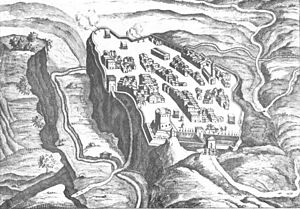Wars of Castro
| The Wars of Castro | |||||||
|---|---|---|---|---|---|---|---|
 The city of Castro, on which the Wars of Castro centered. |
|||||||
|
|||||||
| Belligerents | |||||||
| Papal armies of Pope Urban VIII and Pope Innocent X |
|
||||||
| Commanders and leaders | |||||||
|
Antonio Barberini Fabrizio Savelli, later replaced by Taddeo Barberini Luigi Mattei as commander of papal loyalists and hired mercenaries Achille d'Étampes de Valençay and Cornelio Malvasia as commanders of cavalry |
Mattias de' Medici as commander of the forces of the Republic of Venice, the Grand Duchy of Tuscany and the Duchy of Modena and Reggio Raimondo Montecuccoli as commander of mercenary Modenese forces loyal to Francesco I d'Este |
||||||
Mattias de' Medici as commander of the forces of the Republic of Venice, the Grand Duchy of Tuscany and the Duchy of Modena and Reggio
The Wars of Castro were a series of conflicts during the mid-17th century revolving around the ancient city of Castro (located in present-day Lazio, Italy), which eventually resulted in the city's destruction on 2 September 1649. The conflict was a result of a power struggle between the papacy – represented by members of two deeply entrenched Roman families and their popes, the Barberini and Pope Urban VIII and the Pamphili and Pope Innocent X – and the Farnese dukes of Parma, who controlled Castro and its surrounding territories as the Duchy of Castro.
Papal politics of the mid-17th century were complicated, with frequently shifting military and political alliances across the Catholic world. While it is difficult to trace the precise origins of the feud between the duchy of Parma and the papacy, its origins can be looked for in political maneuverings occurring in the years or even decades preceding the start of military action.
In 1611 a group of conspirators, nobles from Modena and Mantua, was accused of devising a plot to assassinate Ranuccio I Farnese, Duke of Parma and other members of the Farnese family in Parma. In reality, the plot had been "uncovered" when a prisoner (being held for unrelated crimes) confessed to it and implicated members of various noble houses. Though the accusations were likely untrue, 100 of the "conspirators" were tortured and eventually executed in Parma's main square in 1612. Many of their estates were confiscated leaving a large number of now legitimately discontented nobles. Until his death in 1622, Ranuccio remained paranoid about future assassination attempts and about curses from witches and heretics. He persecuted "witches" and alleged conspirators savagely and even had his own mistress, Claudia Colla, burned to death. He remained convinced that other noble families were plotting his downfall.
...
Wikipedia
